Which product is better for cesspools: a review of live bacteria, antiseptics and chemistry
One of the most pressing issues that owners of private houses have to resolve is wastewater disposal.But a properly selected product for cesspools can not only minimize the use of a sewage disposal machine, but also provide a garden with safe, high-quality fertilizer.
We will tell you which option will be optimal for the treatment facilities of your autonomous sewer systems. We describe in detail all the compositions used in practice, and evaluate their effectiveness. The information we provide will help you choose the optimal remedy.
The content of the article:
Methods for cleaning cesspools
Any cesspool needs periodic cleaning, the frequency of which is determined by the intensity of use.
Disinfection and disposal of wastewater can be carried out in several ways:
- Mechanical cleaning. It consists of the isolation and subsequent removal of insoluble large particles of mineral origin from the wastewater. It is carried out by settling and filtration. The mechanical method does not allow to get rid of insoluble compounds, therefore it is used as a complement to chemical and biological purification technologies.
- Biological treatment. The method is based on the use of aerobic and anaerobic varieties of living bacteria for septic tanks and cesspools. They ensure the conversion of wastewater into sludge and water.Decomposition into these components occurs due to initial oxidation with the help of anaerobic bacteria, followed by post-purification by aerobes.
- Chemical cleaning. The methods are based on the principle of converting soluble compounds using reagents into sparingly soluble compounds, after which they precipitate. The method is used primarily for the treatment of industrial wastewater and fecal matter.
Chemical and biological technologies are associated with the use of wastewater treatment products. An option for domestic conditions is most often septic tanks with one, two or three chambers.
In the first chamber, wastewater is fermented with the assistance of anaerobes, in the next chamber it is finalized and prepared for discharge into filtration fields or discharge into filtration ditches.
The more chambers a septic tank has, the higher the degree of wastewater treatment. Water from three-chamber structures can flow into the soil without additional treatment. There, in natural conditions, they will be further purified, so they will not disturb the natural ecological balance.
Water from two-chamber and single-chamber septic tanks must flow either into a centralized sewer network or into absorption wells. Therefore, structures with one or two chambers are used primarily for processing gray waste, and the masses from “latrines” are discharged into cesspools, backlash or powder closets.

All types of cleaning are associated with the formation of sediment, which should be periodically pumped out and removed. The sludge formed during chemical treatment is pumped out and transported for disposal at central treatment facilities.The sediments obtained as a result of biological processing, after aging in compost heaps, are used as fertilizers.
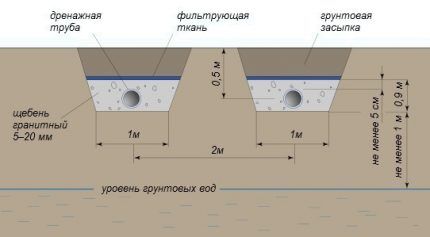
Main requirements for wastewater treatment products cesspools are the ability to minimize the volume of fecal matter, the ability to process filtered solids, paper and cellulose.
Not the least important factor is the possibility of treating household wastewater, which may contain chlorine compounds, acids, alkalis, and phenols.
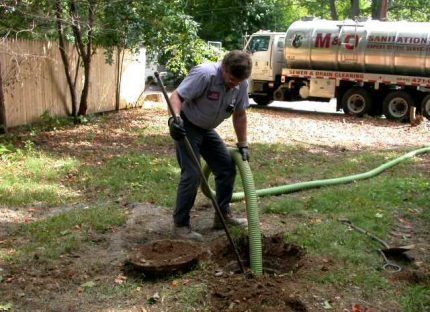
Chemical means for cleaning cesspools
Chemicals used to clean cesspools can be divided into several main subgroups:
- Formaldehyde;
- Ammonium compounds;
- Nitrate oxidizers;
- Bleaching powder.
Chemical compounds used for cleaning have a number of advantages and disadvantages.
The strengths of cesspool chemistry are as follows:
- Chemicals are effective at any temperature, while the temperature range for living bacteria is +4 -(+30) degrees.
- The effectiveness of cleaning with chemicals is not affected by the hardness of the water and the content of antiseptic substances in it.
In terms of application possibilities, biological technologies are inferior to chemical analogues, because Microorganisms useful for cesspools die in an environment containing an antiseptic and under unfavorable temperature conditions.
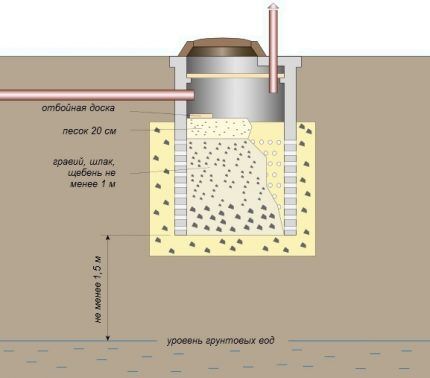
Negative aspects of using chemical antiseptics to clean cesspools:
- Corrosive effect on metal pipes and certain types of plastic. With prolonged contact, the structure of these materials loses its integrity and collapses.
- Vapors and gases inevitably released during chemical cleaning of cesspools have a negative impact on the environment. When it gets into the soil, beneficial enzymes are destroyed and almost all microorganisms die.
- Chemicals lead to the accumulation of pathogenic bacteria in the cesspool. In this regard, even chemically purified wastewater cannot be used as fertilizer.
By its nature, almost any cleaning chemical is aggressive to the environment. Therefore, you need to use it with extreme caution chemicals for wastewater treatment, preventing decomposition products from entering the soil and underground aquifers.
Formaldehyde for disinfection and cleaning
Recently, the use of formaldehyde was not only the cheapest, but also the most common method of disinfecting a cesspool.Due to the fact that preparations based on formaldehyde, otherwise called formalin, are highly carcinogenic, they are increasingly used for wastewater treatment.
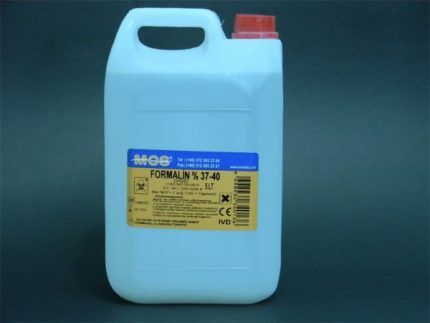
Most often, formalin is used as a disinfectant; it can not only destroy all living bacteria, but also stop the process of decomposition of the contents of the cesspool, which is often accompanied by the release of toxic gases.
Ammonium salt compounds
Preparations based on ammonium compounds have high disinfection properties. They not only significantly stimulate the decomposition of sewage, but also perfectly neutralize unpleasant odors released from the cesspool.
Ammonium salts belong to the category of onium compounds, which contain structures of tetravalent nitrogen. Under the influence of water, ammonium preparations are converted into a solution with concentrated alkali, which ensures the effective decomposition of the contents of the cesspool.
Ammonium preparations work effectively in the absence of household chemicals and detergent components in the drains of the joint sewer system, which removes fecal matter along with “gray” water.
It is known that ammonium salts have a very negative impact on human health and the environment, but the mechanism of their effect has not been fully studied.
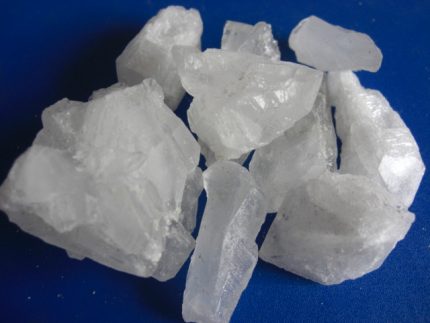
In this regard, ammonium salts are recommended to be used to neutralize sewage only if a storage tank built 20 m from the house is completely sealed and human contact with fumes is prevented. When emptying a cesspool disinfected with ammonium salts, it is necessary to use vacuum pumping.
Specifics of using nitrate oxidizers
In comparison with formalin and ammonium compounds, nitrate oxidizing agents are gentle drugs. When disinfecting cesspools with nitrate oxidizers, decomposition products can be used in the form of fertilizers with some restrictions.
Nitrate oxidizers do an excellent job of decomposing solid waste and fecal matter, neutralizing specific odors and converting the contents of the cesspool into a homogeneous substance. To obtain the safest fertilizer, nitric acids should be used as nitrate oxidizers.

The only disadvantages of nitric acid compounds are their high cost and aggressive effect on metals, upon contact with which nitrates are deposited on their surface. If there are steel pipes in the cesspool, they can become “overgrown” due to contact with nitric acids.
Features of using bleach
Bleach is widely used for disinfection and cleaning cesspools due to its cheapness. Like formaldehyde, bleach is highly carcinogenic.Despite the fact that it belongs to the category of disinfectants, it is still toxic to the human body.
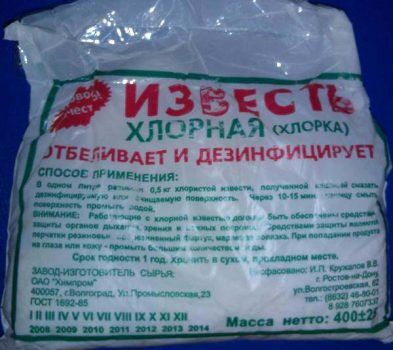
Bleach should be used with extreme caution, following the manufacturer's recommendations for working with the chemical. It should be taken into account that the powder should be stored in a dark place, since in bright light, as a result of the decomposition of bleach, a loss of active chlorine is observed.
Rules for choosing cleaning chemicals
Before purchasing the drug, you need to determine the need for further use of recycled sewage and wastewater. If you want to use treated wastewater as fertilizers, then it is better to abandon chemicals. As a last resort, you can use nitrate salts, which are the least hazardous to the environment.
Due to the fact that chemicals, by their nature, are aggressive to various materials, it is not superfluous to take into account the material of the walls of the cesspool and the presence of pipelines in it. You should choose chemistry as carefully as possible when using a fecal pump, the surface of which is most affected by chemicals.
If household chemicals or detergents get into the cesspool, they can affect the effectiveness of the chemicals. Some chemicals, when reacting with detergents and household chemicals, are partially or completely neutralized, so it is a good idea to study the instructions or consult about compatibility.
Biological products for cesspool
If they are used to decompose sewage from a cesspool environmentally friendly drugs based on enzymes and living organisms, this method of purification is called bacterial-enzymatic.
All bacterial and enzymatic wastewater treatment preparations have the following qualities:
- Converting waste into a safe mass. The sludge obtained as a result of the activity of bacteria is a valuable fertilizer, rich in organic matter and minerals.
- Safe for people, do not cause allergic reactions or skin irritation even in case of direct contact.
- Helps eliminate odors and excess gas formation during the decomposition process.
- When in contact with any materials of inorganic origin, they do not show aggression. This fully applies to metal, plastic, plastic, concrete, brick, which are most often used for sewerage and cesspool walls.
- They are able to work effectively only at positive temperatures; they show the greatest activity in the temperature range from +3 to +30 degrees. Although there are exceptions, there are preparations based on bacteria that can work well at temperatures up to +45 degrees.
- Sensitive to household chemicals and detergents.
- They are suppressed and can almost completely die when combined with chemical cleaning agents - concentrated alkalis and acids, phenols, aldehydes, active chlorine. The survival of bacteria depends on the concentration of the chemistry.
It should be taken into account that although live bacteria are effective for cesspools, they are still not recommended for use in winter and cannot be combined with chemicals.
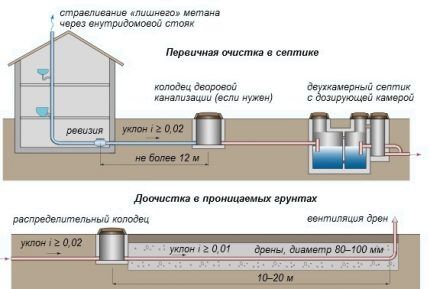
By their nature, microbes for cesspools can be classified into 2 groups:
- Aerobic. They work only in conditions of unhindered supply of oxygen necessary for their life. To do this, either provide its free access in an unlimited volume, or pump the gas with compressors. Aerobes are capable of processing almost all substances entering the cesspool and destroying harmful microbes, purifying and disinfecting water before it enters the filtration fields or absorption well.
- Anaerobic. They work in closed, sealed containers that prevent the penetration of oxygen. Such cultures serve for preliminary fermentation of wastewater with the help of methane-producing microorganisms. Fermentation takes 2-3 days, then the prepared mass is available to aerobes.
For bacteria to work effectively, sudden temperature fluctuations must be avoided. Preference should be given to those biological drugs, which have been adapted to chemistry and are able to work in complete darkness.
Preparations that provide biological treatment of wastewater can be produced in various forms.
The release form is determined by the following parameters:
- The type of bacteria used;
- Composition of the drug;
- Frequency of application;
- Ease of use.
Most often, biologically based drugs are available in the form of granules and powders, liquid formulations and tablets. Each of the presented biological products has its own dilution characteristics and varying efficiency of waste decomposition.
Powder formulation options
They are produced in the form of a dry powder, the composition of which contains a group of microorganisms and enzymes. The drug is convenient for transportation; it is packaged in containers and containers of various sizes.
Powder compositions have the following characteristic features:
- The drug consists of saprophytic anaerobic bacteria grown under artificial conditions.
- The composition can be sold either in powder form or in the form of a granular mixture.
- Bacteria in the form of granules or powder are in suspended animation and require activation.
Most often, bacteria are activated by adding warm water in the proportions specified by the manufacturer. Sometimes it may be necessary to add sweetness or organic matter to activate bacteria. A sign of the awakening and beginning of bacterial activity is the release of carbon dioxide, which is manifested by the release of bubbles on the surface.
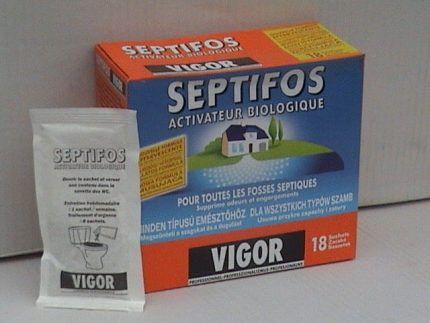
The instructions should not be neglected, since incorrectly awakened bacteria will not bring any positive effect after being introduced into the cesspool.
Liquid concentrated products
Liquid biological preparations have a high concentration of microorganisms. They contain a complex of anaerobic bacteria that effectively decompose almost any organic impurity. When exposed, household waste decomposes into water and carbon dioxide.
The main distinguishing feature of liquid products is the small volume required for a large amount of waste.Due to the high concentration of the solution, 1 liter of the drug will be enough to process 2 cubic meters of wastewater. The recommended volume of the drug is indicated by the manufacturer.
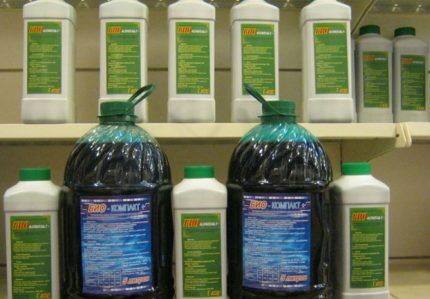
Liquid products may require dilution with warm water or pour directly into cesspool without bottom and with the bottom. In any case, the container with bacteria must be kept at room temperature and ensure that the vital activity of bacteria is activated. The container with bacteria should not be left exposed to bright light during the awakening period.
Drugs in tablet form
The tablet form of biological products is considered the most convenient to use. It is enough to place the cleaning tablets for the cesspool into a container with sewage, and the anaerobic bacteria will begin their work. The amount of the drug is determined by the volume of the pit and is indicated in the instructions for use.
The basis of tablet preparations are anaerobic bacteria, which work well in the dark in the absence of oxygen. In addition to tablets, biological products can be produced in the form of cassettes with colonized microorganisms or in the form of self-dissolving bags.
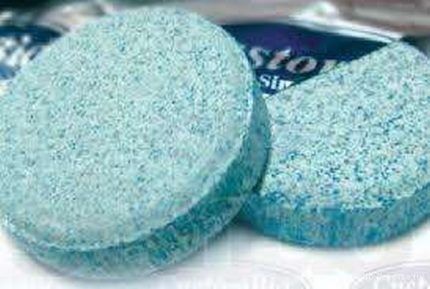
The tablets perfectly dissolve solid bottom sediments, which allows you to avoid work on deepening the cesspool. In addition, they perfectly purify wastewater from suspended particles and neutralize unpleasant odors.
When purchasing tablet drugs, you need to pay attention to the life activity of bacteria. This is due to the fact that there are tablets based on aerobic bacteria used in septic tank treatment plants. Such preparations are not suitable for cleaning cesspools, since their activity requires oxygen.
Review of the best brands and brands
Taking into account the fact that chemicals are increasingly having a negative impact on the environment, biological products are becoming increasingly popular.
The most popular on the market of biological products for cleaning cesspools are:
- Bioactivator Sanex. Available in powder form, which should be infused in warm water for 20 minutes to activate bacteria. Sanex, in addition to sewage, copes well with fats, starches, paper and organic fibers. The water obtained as a result of purification can be used for irrigation.
- Doctor Robik. It contains more than a hundred types of microorganisms, which allows, in addition to organic matter, to easily cope with the decomposition of phenols, fats and detergents. A sachet of the drug is capable of cleaning 5 cubic meters of wastewater. If there is little water in the cesspool, then for efficient operation drug Doctor Robik you need to replenish the fluid deficit.
- Bioactivator "Green Pine". In addition to bacteria, the drug contains organic carriers, enzymes, and pine flavoring. In addition to excrement, it copes well with fats and minimizes the reproduction of generations of flies. The drug ensures the processing of the contents of the pit to the state of fertilizer.
- Micropan. Available in powder and liquid form, there is also a tablet form.Optimally combined bacteria and enzymes cope with the processing of excrement and paper into a safe mass.
- Bio-sept. Used as a universal remedy for cesspools. Helps liquefy bottom sediments, cope with fats and excrement, and neutralizes surfactants. The bacteria of the drug are strongly suppressed by chlorine-containing substances.
All biological products cope well with organic waste, and their effectiveness is determined by the environment present in the cesspool. There are simply no special criteria for choosing organic preparations; for them to work effectively, you must strictly adhere to the manufacturer’s recommendations.
With device and technology construction of a cesspool at the dacha site, you will be introduced to the article we have proposed.
Conclusions and useful video on the topic
Video #1. Cleaning a cesspool with nitrogen fertilizers:
Video #2. Tips for using bacteria to neutralize unpleasant odors and decompose sewage in a cesspool:
Video #3. Recommendations for working with biological products Dr. Robik:
By choosing a chemical disinfection method, you are putting your health at risk and harming the environment. Even a one-time use of chemicals will forever eliminate the possibility of using microorganisms.
Although microbes and bacteria for treating cesspools have limitations, it is still better to give preference to them as an effective and safe means of cleaning.
Would you like to tell us what composition you used to treat a cesspool? Please write comments in the block below. Ask questions, share your impressions, useful tips and photographs.




I read here that the drug Devon-N is not suitable, or rather, has a bad effect on metal pipes. Just because of my allergic diseases, oddly enough, I can only tolerate nitric acids. And the cesspools need to be cleaned. And it’s easier for me to adapt to this drug. Tell me which pipes should be connected to the cesspool so that nitric acids do not harm them?
Well, you can install plastic pipes. Although on the packaging of Devon-N the manufacturer indicates that the product does not damage plastic, rubber, and does not cause metal oxidation. So I’m not sure that the material says correctly about the dangers of metal.
We had just installed a “country” toilet and had a choice. It’s clear that you will have to call the sewer trucks periodically for any reason, but in order to reduce the number of their calls, they have not yet decided what to prefer: chemistry or bacteria. Will bacteria do their job normally in winter? Also a question. Pouring everything in there and then harming the environment is a dubious idea. The question still remains open, although, in my personal opinion, bacteria are much more “humane” for nature.
It depends where you live and what kind of winters you have. Bacteria work at +4-5 degrees; if the temperature drops below, they hibernate. In the spring, when the temperature stabilizes above 5, you need to fill it with a “starter” biological product and they will work with renewed vigor.
Too much information. Simply confused.
I have a sewer pit. The result of the washing machine, toilet, and kitchen sink is drained there. Naturally, there is one or another chemistry inherent in the above pollutants)))
Over many years of use, thick matter has accumulated at the bottom of the pit, mainly from fecal matter. Although this is only a visual inspection. Surely there are fats and other derivatives of detergents in the thickener.
I immediately rule out a sewer truck - it is unlikely to handle 30 meters of pipe plus lifting all this thick stuff from a depth of 3 meters.
So the question arises: what means to use to process this thicket? The sewer pit is located in the corner of the garden, so the chemical method should probably be excluded.
And how did you solve the problem Alexander?
Please advise! A new well was built. The analysis found coliform bacteria (Intestinal bacteria) Toilet at a distance of 20m. The barrel is buried. Lives 1 person. The proposed biological preparations were poured into the barrel. Over the summer, sewage accumulated by 30-30 cm per 200 liters. barrel Once every two years, the sewer trucks cleaned out the waste. There was nothing to worry about. But due to the fact that there are more in the area 50m. there is nothing harmful, the sin is that the barrel became leaky over time and sewage seeped into the ground and contaminated the stream that is now going into the well. We decided to remove the toilet from this place. What and how to neutralize this place?